List of Sydney Harbour ferries
This is a list of passenger ferries operating or formerly operating on Sydney Harbour. It includes ferries serving the Manly run.
| Name | Year Built | Description | Origin of name | Tons | Length (m) | Passengers | Class/Type | Out of service |
|---|---|---|---|---|---|---|---|---|
| Rose Hill Packet | 1789 | A hoy launched in 1789, in the year following the settlement of Sydney. Also known as 'The Lump', it was used to transport goods and passengers up the Parramatta River. The return journey could take a week between Sydney and Parramatta. | 12 tons (bm) | 11 m-13 m | Packet or Hoy | c.1800 | ||
| Surprise | 1831 | Launched in 1831 in Neutral Bay for the Parramatta service, Surprise was the first Australian built steamship and the first steam ferryboat in Sydney. In service for six months with limited financial success. Her draught was too deep for the route and she was sent to Tasmania. Sold to Hobart in 1832.[1][2] | 40 tons | 24 m | Paddle steamer | 1832 | ||
| Sophia Jane | 1826 |  | 38 m | Auxiliary steamer | ||||
| Experiment | 1832 | Due to high cost and difficulty in sourcing steam engines at the time, this vessel used horses on treadmill attached to a central wheel to propel her via paddle wheels. Provided a Sunday's-only service to Balmain from 1840. Converted to steam and in 1846 was sent to Brisbane to become that town's first ferry.[1][4] | Unusually had horses drive paddle wheels. | 38 tons | 24 m | 100 | Paddle steamer | 1846 |
| Australia | 1834 | Paddle steamer built by the Australia Steam Conveyance Company for Parramatta service for a cost of £200. 12 hp (9 kW) steam engines. A financial success with the company paying a dividend in 1836 of 38 per cent, possibly because there was little competition apart from sailing craft. Withdrawn from Parramatta service following the introduction of Comet (1843) and used on Balmain, Five Dock, and Iron Cove runs.[1][4][5] | 45 tons | 25.3 m | Paddle steamer | 1863 | ||
| Rapid | 1837 | Second vessel ordered by the Australian Steam Conveyance Company following the success of Australia (1834). Built in the United Kingdom and sent to Sydney for re-assembly. The first double-ended ship in Australia. Copper boiler, 20 hp (14.9 kW) engine, iron hulled. Ninety-minute trip on Parramatta service. Ran aground at Glebe Point in 1863 where she was used as a house boat.[1][4][6] | 1852 | |||||
| Kangaroo | 1840 | Paddle steamer built for Parramatta service. Bought in 1847 by Tasmanian Government for use in Hobart. Later worked in Melbourne until 1891.[1] | Australian native animal | 1847 | ||||
| Raven | Paddle steamer built for Parramatta service.[7] | Paddle steamer | ||||||
| Waterman | 1844 | Paddle steamer built for Parramatta service.[7] 8 hp engine. Began frequent services to Balmain run by Messers Flood, Perdriau and Fennmore but the small ferry was unreliable and not popular. | 17 tons | 15 m | Paddle steamer | 1874 | ||
| William IV | Unusual style of paddle wheel.[8] | |||||||
| Emu | 1843 | .jpg) | Australian native bird | 65 tons | 28.6 m | 150 | Paddle steamer | 1884 |
| Comet | 1843 |  | 50 tons | 30.1 m | Paddle steamer | 1862 | ||
| Native | 1844 | Boiler exploded in 1850, renamed Maid of the Mill and later sold to Brisbane.[13] | 18.3 m | Paddle steamer | 1862 | |||
| Ferry Queen | 1844 | _QUEEN.jpg) | - | 8 tons | 40 | ? | ||
| Gypsy Queen | 1844 | Wooden paddle steamer built by Thomas Chowne, Pymont for Gerrard brothers.[14][15] | - | 8 tons | 40 | |||
| Brothers | 1847 | .jpg) | Named after owners John and Joseph Gerrard.[10] | 50 tons | 20.6 m | 50 passengers | 1886 | |
| Cobra | 1849 | Iron paddle tug built in Swansea, South Wales. Designed as a tug-tender, she worked in Melbourne then Launceston, and then Hobart before working in Sydney from 1869. Her main Sydney role was a tug, and sometimes as a cargo vessel. On occasion, she would transport passengers to Manly. Transferred to Newcastle in 1874, and lasted until circa. 1917.[17] | 1874 to Newcastle | |||||
| Agenoria | 1850 | a Gerrard Brothers boat. Sold to Melbourne 1852.[14] | 22 tons | 15.8 m | 1852 | |||
| Star | 1852 | Wrecked in 1857 | 44 tons | 22.3 m | 1857 | |||
| Mystery | 1852 | Wooden paddle steamer built by Money Wigram & Co, Northam, England. 60 hp 2 x grasshopper side lever steam engines by George Butchard. 9 knots. 60 hp 2 x oscillating steam engines. 11 knots. Imported by Manly Ferry Company to join Royal Alfred as a tug, cargo carrier, and excursion ferry. Converted to a lighter 1893 | 141 tons | 40.3 m | 750 | 1893 | ||
| Black Swan | 1854 | Iron paddle steamer built by C.J. Mare & Co, Blackwell, England and reassembled in Sydney for Parramatta service.[7] 35 hp oscillating steam engine. Sister to Pelican, similar to Emu. In 1859 and 1860, ran Sunday and holiday services to Mosman with Perri. Also used to provide services to Manly. Rebuilt and lengthened in 1865. Wrecked 4 June 1868.[10][11] | 40 tons, 1865: 69 tons | 27.6 m, 1865: 33.5 m | 150 | Paddle steamer | 1868, wrecked | |
| Pelican | 1854 | Paddle steamer built for Parramatta service. Sister to Black Swan, similar to Emu. Also used to provide services to Manly. Sank 3 April 1888.[7][10][11] | 42 tons | 27.6 m | 165 | Paddle steamer | 1888 | |
| Herald | 1854 | 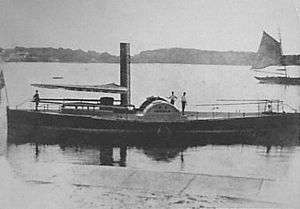 | 22.9 m | 50 | 1884 | |||
| Premier | 1856 | 19 tons | 23.2 m | Paddle steamer | 1891 | |||
| Pearl (I) | 1856 | 11 tons | 16.8 m | Paddle steamer | 1891 | |||
| Peri | 1856 | 22 tons | 16.8 m | Paddle steamer | 1886 | |||
| Nautilus (I) | 1856 | a North Shore Ferry company vessel.[14] | 36 tons | 16 m | 1891 | |||
| Phantom | 1858 | 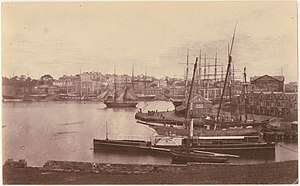 | 63 tons | 36.3 m | 160 | Manly ferry, paddle steamer | 1886 | |
| Ysobel | 1860 | Built by P.N. Russell & Co. Sydney. Joubert's first ferry, to Hunters Hill. Possibly Sydney's first screw-propelled ferryboat, however, there is no confirmation that it was not a paddle steamer.[19] | ||||||
| Kirribilli (I) | 1861 | A small double-ended wooden paddle steamer steered with a tiller at either end. Built by John Cuthbert, Sydney. 8 hp power steam engine. First ferry in North Shore Ferry Company[14] Then transferred to be the second ferry on the Hunters Hill run. | Australian Aboriginal name meaning 'good fishing spot', and name of a Sydney suburb | 11 tons | 60 | 1879, wrecked | ||
| Cygnet | 1862 |  | young swan | 30 tons | 27.1 m | Paddle steamer | 1891 | |
| Gypsy Queen | a Gerrard Brothers boat.[14] Took over from Waterman on the Balmain run in 1846. | |||||||
| Emu (II), later Brightside | 1865 |  As Emu (II) | 269 tons | 52.1 m | 800 | Paddle steamer | 1908 | |
| Adelaide, later Swan | 1866 | .jpg) | 1900(?) | |||||
| Transit | 1866 |  | 69 tons | 24 m | ||||
| Galatea | 1868 | a North Shore Ferry company vessel.[14] | 21 m | |||||
| Royal Alfred | 1868 | 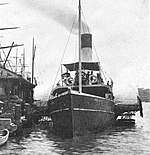 c. 1890 | 141 tons | 40.3 m | 750 | 1893 | ||
| Florence | 1872 | Wooden screw steamer built by W. Dunn, Lavender Bay. 8 hp steam engine by Chapman & Co. A North Shore Ferry company vessel.[14] Provided first regular daytime runs to Mosman. | 15 tons | 16.9 m | 1900 | |||
| Coombra | 1872 | a North Shore Ferry company vessel. Burnt out 1888.[14][20] | 45 tons | 23.8 m | 1888 | |||
| Leipoa | 1872 |  | scientific name for Malleefowl | 49 tons | 27.4 m | 1918 | ||
| Aberona | 187? | Serviced the Mosman and Neutral Bay routes[18] | ||||||
| Bungaree (Beengaree) | 1873 | 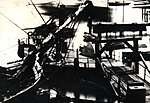 | Horse punt | 61 tons | 23.7 m | (punt) | 1900 | |
| Darra | 1875 | a North Shore Ferry company vessel.[14] | 57 tons | 24.9 m | 1883 | |||
| Nellie | 1877 | 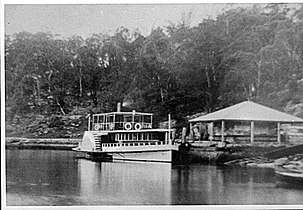 | 69 tons | 25.4 m | ? | |||
| Commodore | 1878 | _from_Fred_Hardie_-_Photographs_of_Sydney%2C_Newcastle%2C_New_South_Wales_and_Aboriginals_for_George_Washington_Wilson_%26_Co.%2C_1892-1893_(9021427305).jpg) | 187 tons | 1854 | ||||
| Victor | 1878 | a Gerrard Brothers boat.[14][25] | 24 tons | 15.8 m | ? | |||
| Nell | 1878 | a North Shore Ferry company vessel.[14] Wrecked 1883.[26] | 71 tons | 25.4 m | 1883 | |||
| Fairlight | 1878 | 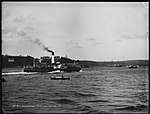 | A suburb near Manly. | 315 tons | 52.1 m | 950 | Manly ferry, paddle steamer | 1914. |
| Wallaby | 1879 |  Shown after her wheelhouses closed in | a native Australian animal | 163 tons | 32.9 m | 329 | - | 1918 |
| Bennelong or Benelon | 1880 | 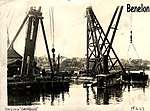 raising sunken Benelon | Bennelong was a senior man of the Eora | 204 tons | 36.6 m | 28 vehicles, 84 passengers | Vehicular ferry | 1932. |
| Rose | With Swansea, provided the first regular Watsons Bay services | |||||||
| St Leonards | 1880 | 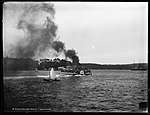 | a Sydney suburb | 110 tons | 33.5 m | 475 | - | 1901. |
| Alathea, Aleathea | 1881 |  | 79 tons, 1892: 120 tons | 33.3 m | 500 | 1913 | ||
| Lily | 1882 |  | 66 tons | 23.0 m | 250 | - | 1911 | |
| Eagle, later Cygnet | 1882 | 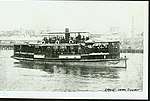 As built, as Eagle | 74 tons | 23.9 m | 370 | - | 1931 | |
| Brighton | 1883 | .jpg) | 67.1 m | 1200 | Manly ferry, paddle steamer | 1916 | ||
| Port Jackson | 1883 | 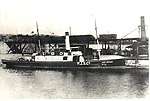 | 108 tons | |||||
| Balmain | 1883 |  | Sydney suburb | 117 tons | 36.5 m | Paddle steamer | 1910 | |
| Victoria | 1883 | 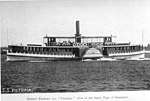 | 119 tons | 34.1 m | 434 | 1910(?) to Melbourne | ||
| Warrane | 1883 | .jpg) | 109 tons | 30.2 m | 14 vehicles, 144 passengers | Vehicular ferry | 1931 | |
| Halcyon | 1884 |  c. 1890, as built | 82 tons | 30.2 m | 290 | 1933 | ||
| Gannet | 1884 | 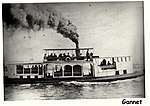 | 48 tons | 19.8 m | 213 | 1930s | ||
| Cammeray | 1884 | 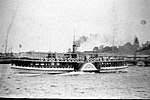 | Cammeray is named after the Cammeraygal tribe | 197 tons | 39.3 m | 675 | 1908 | |
| Possum | 1884 | Wooden screw steamer. Built by Rock Davis, Blackwall. 12 hp steam engine by Chapman & Co. First all-night North Shore service. Sunk 1911 | 32 tons | 17.8 m | 1911 | |||
| Neutral Bay, later Thelma | 1885 | Renamed Thelma in 1897.[26] | A Sydney harbourside suburb | 50 tons | 21.0 m | 1920s | ||
| Bunya Bunya | 1885 |  shown circa 1900 | Araucaria bidwillii, the bunya pine | 202 tons | 64.6 m | 688 | Paddle steamer | 1914 |
| Waratah (II) | 1885 | .jpg) c. 1886 as built without shelter for captain | Australian-endemic genus of large shrubs including the NSW State floral emblem. | 197 tons | 36.6 m | 695 | Paddle steamer | 1910 |
| Lincoln | 1886 |  | 117 tons | 36.5 m | 400 | |||
| Leichhardt | 1886 | 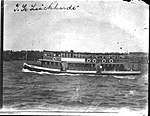 | 68 tons | 23.1 m | 370 | |||
| Lotus | 1886 |  | 70 tons | 22.6 m | 268 | 1918 | ||
| Narrabeen (I) | 1886 |  | Narrabeen | 239 tons | 48.8 m | Manly ferry | 1917 | |
| Swansea | 1887 | With Rose, provided the first regular Watson's Bay services[38] | 60 tons | 359 | ||||
| Me Mel | 1888 |  | 174 tons | 38.1 m | 580 | paddle steamer | ||
| Bee | Served the Watson's Bay run.[38] Unusually, had a canoe stern. Replaced by ex-Balmain ferry, Bald Rock, and sent to Brisbane. | |||||||
| Oceana | 1886 | Served the Watson's Bay run, wrecked on the bar of Manning River while en route to work for Manning River Ferry Company.[38][39] | 34 tons | 18.2 m | 240 | 1903 | ||
| Jenny Lind | Served the Watson's Bay run for the Watson Bay Regular Steam Ferry Company | |||||||
| Golden Rose | 1872 | Served the Watson's Bay run for the Watson Bay Regular Steam Ferry Company. Also served on early Mosman services in 1870s.[18] | 12 tons | 11.4 m | 1891 | |||
| Zeus | 1878 | Served on early Mosman services in 1870s.[18] Wrecked 1892 | 16 tons, 1898: 35 tons | 16.0 m | 1892 | |||
| Speedwell | Served on early Mosman services in 1870s.[18] | |||||||
| Matilda | Served on early Mosman services in 1870s.[18] | |||||||
| Mascotte | Served the Watson's Bay run for the Watson Bay Steam Ferry Company | |||||||
| Elaine | 1882 | Served the Watson's Bay run for the Watson Bay Steam Ferry Company. | 18 tons | 15.4 m | 310 | 1914(?) | ||
| Petrel | 1883 | Served the Watson's Bay run for the Watson Bay Steam Ferry Company | 26 tons, 1898: 35 tons | 18.1 m | ||||
| Admiral | 1883 |  | 121 tons | 31.1 m | 1896, to New Zealand | |||
| Psyche | 1884 | 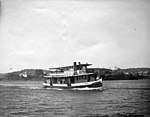 | 42 tons | 21.4 m | ||||
| Marra Marra | 1884 | One of several ferries in the early 1890s, used by the Manly Co-operative Steam Ferry Limited set up to compete, ultimately unsuccessfully, with the Port Jackson Steamship Company. | 66 tons | 25.3 m | 1896, to New Zealand | |||
| Victor | Served the Watson's Bay run for the Watson Bay Regular Steam Ferry Company | |||||||
| Bald Rock |  | location in Balmain | 105 tons | 34.3 m | Paddle steamer | 1907 | ||
| Courier | 1887 |  Courier right side | 65 tons | 22.8 m | 300 | |||
| Genista | 1886 | 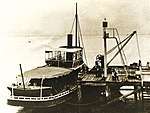 | 24.3 m | 200 | 1889 (to Victoria) | |||
| Pheasant | 1887 | 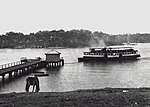 as modified early 1900s | 138 tons | 33.5 m | 460 | 1914(?) | ||
| Birkenhead | 1888 | 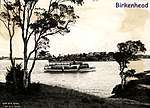 | Sydney locality | 115 tons | 26.5 m | 440 | ||
| Kangaroo (II) | 1891 |  |
Australian native animal | 158 tons | 34.1 m | 632 | K class | 1926 |
| The Lady Mary | 1892 |  | 79 tons | 25.3 m | 393 | Lady class, first series | 1928 | |
| Lady Napier | 1892 | 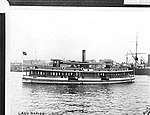 | 89 tons | 29.9 m | 450 | Lady class, first series | 1920 laid up(?) | |
| Lady Manning | 1893 | 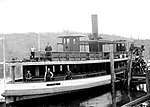 | 97 tons | 33.2 m | 475 | Lady class, first series | 1928 | |
| Conqueror | 1893 |  | ||||||
| Waringa Karaga | 1894 | 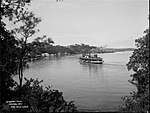 as Waringa (circa 1905-1907) | 125 tons | 32.2m | 588 | K class | 1943 | |
| Barangaroo | 1896 |  | Wife of Bennelong, a senior man of the Eora | 205 tons | 36.4 m | 26 vehicles, 86 passengers | Vehicular ferry | 1932 |
| Manly (II) | 1896 | 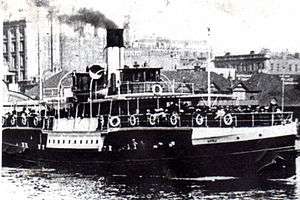 | 229 tons | 44.8 m | 820 | Manly ferry | 1924 | |
| Wallaroo Kiamala | 1896 |  Wallaroo as built | Wallaroo, Australian native animal. | 122 tons | 32.4 m | 545 | K class | 1943 |
| Lady Hampden | 1896 |  | 135 tons | 35.1 m | 636 | Lady class, first series | 1942 | |
| Carabella Karabella | 1897 | Wooden screw steamer. Sister to Wallaroo/Kiamala.[37] Built by Young, Son & Fletcher, Rozelle for North Shore Steam Ferry Company (later Sydney Ferries Limited) 30 hp compound steam engine by Muir & Houston Ltd. Received electric lighting 1901. Rebuilt, extended, and renamed Karabella in 1916. On 9 May 1901, collided with Rosedale near Milsons Point and damaged amidships. On 17 January 1902, collided with Sonoma and sponson damaged. Taken out of service following opening of Sydney Harbour Bridge in 1932, however, in 1936 returned to service as an excursion vessel mainly following the 18 footer races. Returned to passenger service in 1939 on Neutral Bay route. Taken over by Australian government in 1943 to assist the war effort.[47][37] | After a house built on North Shore in 1882-'Carrably' | 129 t, 1916: 151 t | 32 m | 595 | K class | 1943 |
| Una | 1898 |  circa 1920s | Australian Aboriginal word meaning 'fancy name' | 44 tons | 20.6 m | 180 | 1927 | |
| Rose | 1898 |  | 80 tons | 25.6 m | 1927 | |||
| Bronzewing | 1899 |  circa 1920s. | a bird | 149 tons | 33.5 m | 500 | 1933 | |
| Kurraba | 1899 | 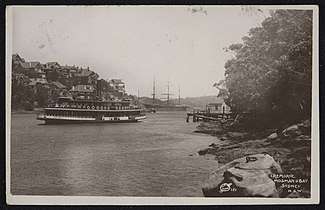 | Sydney harbourside suburb | 195 tons | 40.9 m | 890 | K class | 1934 |
| Kirribilli (II) | 1900 | 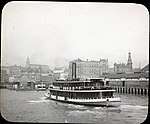 | Australian Aboriginal name meaning 'good fishing spot', and name of a Sydney suburb | 198 tons | 39.7 m | 896 | K class | 1934 |
| Kuring-gai (II) | 1901 | 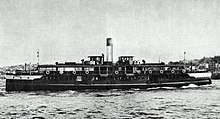 | Ethnonym referring to indigenous Australian peoples from between the Gamilaraay and Sydney | 497 tons | 51.8 m | 1,228 | Manly ferry | 1928 |
| Kamilaroi | 1901 |  | an Australian Aboriginal tribe | 328 tons | 39.0 m | 28 vehicles, 174 passengers.[36] | Vehicular ferry | 1932 |
| Shamrock | 1901 | _(7701488704).jpg) Shamrock is right side foreground | 82 tons | 25.2 m | 420 | |||
| Koree | 1902 | .jpg) Koree carrying regatta spectators | An Australian Aboriginal name for Chowder Bay | 276 tons | 42.8 m | 1,058 | K class | 1934 |
| Kailoa | 1902 |  | 1941 | |||||
| Kummulla | 1903 | 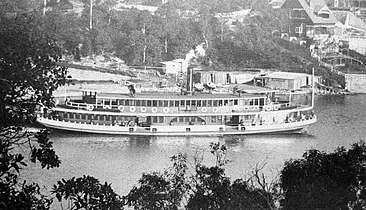 in Mosman Bay | Autralian Aboriginal word for 'catch me' | 168 tons | 36.3 m | 797 | K class | 1934 |
| Lady Rawson | 1903 | 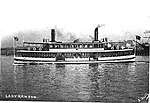 | 172 | 760 | Lady class, second series | 1934 | ||
| Vaucluse (II) | 1905 | 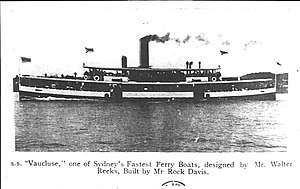 | a suburb in Sydney's east | 121 tons | 42.5m | 709 | 1931 | |
| Kulgoa | 1905 | .jpg) Kulgoa (1905) carrying regatta spectator crowds | Australian Aboriginal word meaning 'returning' | 338 tons | 42.7 m | 1,255 | K class | 1952 |
| Binngarra | 1905 | 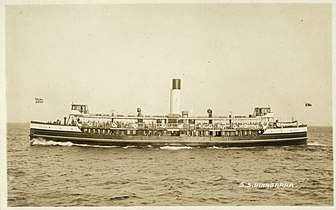 | Australian Aboriginal word meaning 'returning' | 442 tons | 57.9 m | 1372 (summer) / 858 (winter) | Manly ferry, Binngarra type | 1933 |
| Lady Northcote | 1905 |  | Wife of Henry Northcote, 1st Baron Northcote | 128 tons | 35.3 m | 605 | Lady class, second series | 1941 |
| Kareela | 1905 | 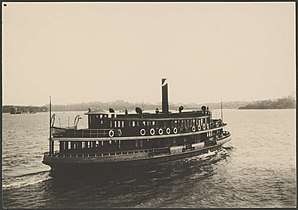 on Sydney Harbour ca. 1930 | Australian Aboriginal word for 'south wind' | 106 tons | 34.4 m | 784 | K class | 1959 |
| King Edward | 1905 |  | 98 tons | 31.1 m | 540 | 1934 | ||
| Lady Linda | 1906 | Part of the Balmain New Ferry Company fleet until that company's takeover by Sydney Ferries Ltd in 1918.[43] | 13 tons | 13.1 m | 1934 | |||
| Kai Kai | 1906 |  | Australian Aboriginal word for 'jewfish' or 'food' | 303 tons | 46.3 m | 1245 | K class | 1942 |
| Kookooburra | 1907 | 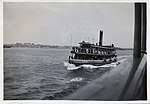 1930s or 1940s | Australian native bird | 180 tons | 42.7 m | 700 | K class | 1948-49(?) |
| Burra-bra | 1908 | 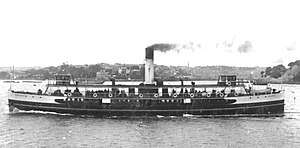 | An Australian Aboriginal name for The Spit.[69] | 458 tons | 59.4 m | 1437 (summer) / 916 (winter) | Manly ferry, Binngarra type | 1942 |
| Lady Carrington | 1908 | 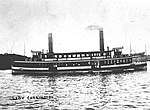 | 146 tons | 39.6 m | 701 | Lady class, second series | 1934 | |
| Killara (II) | 1909 | 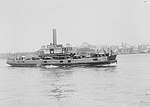 | 309 tons | 40.0 | 49 passengers, 33 vehicles | Vehicular ferry | 1933 | |
| Kaludah, formerly Kuranda | 1909 |  Kaludah 4 March 1911 | 137 tons | 35.1 m | K class | 1911 | ||
| Kanimbla (later Kurra-Ba) | 1910 | 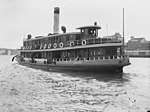 | Australian Aboriginal word for 'Big fight' | 156 tons | 35.4 m | 791 | K class | 1946(?) |
| Bellubera | 1910 |  | Thought to be an Australian Aboriginal word for "pretty lady" or "beautiful woman".[74] | 499 tons (1936: 505 tons) | 64.0 m | 1,490 (summer)/962 (winter). (1936: 1,318) | Manly ferry, Binngarra type | 1973 |
| Kirrule | 1910 | .jpg) | Australian Aboriginal word for 'aroused' | 258 tons | 42.7 m | 1100 | K class | 1951 |
| Lady Chelmsford | 1910 |  | Wife of Governor of NSW, Frederic Thesiger, 1st Viscount Chelmsford | Lady class, third series | 1971 | |||
| Kiandra | 1911 | 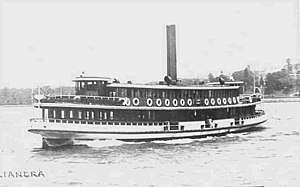 | a corruption of Aboriginal 'Gianderra' for 'sharp stones for knives' and town in NSW | 258 tons | 42.7 m | 1,101 | K class | 1951 |
| Greycliffe | 1911 | 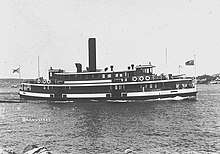 | 133 tons | 38.1 m | 1927 | |||
| Kosciusko | 1911 |  as a steamer, pre-1932 | Australian mountain named after Polish military leader Tadeusz Kościuszko | 165 tons | 35.4 m | 792 | K class | 1975 |
| Balgowlah | 1912 | 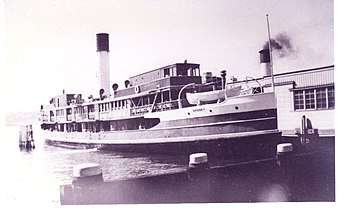 | Name of Sydney suburb | 499 tons | 64.0 m | 1517 (summer) / 982 (winter) | Manly ferry, Binngarra type | 1953 |
| Kanangra | 1912 | 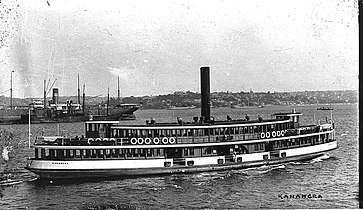 | Australian Aboriginal word for 'beautiful view' | 295 tons | 50 m | 1000 | K class | 1985 |
| Kirawa | 1912 | 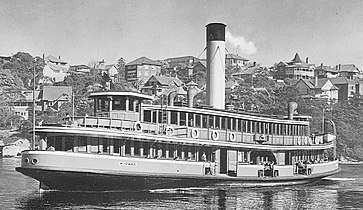 | Australian Aboriginal word for 'looking for them' | - | 50 m | 1000 | K class | 1953 |
| Kubu | 1912 | 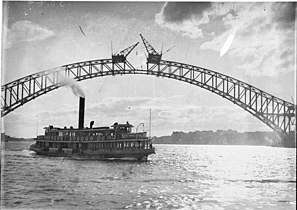 | Australian Aboriginal word for 'oak tree' | 258 tons | 42.7 m | 1072 | K class | 1959 |
| Kamiri | 1912 | 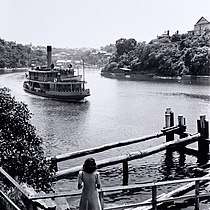 in Mosman Bay 1946 | Name of Aboriginal Australian tribe | 144 tons | 34.1 m | 594 | K class | 1951 |
| Lady Denman | 1912 | 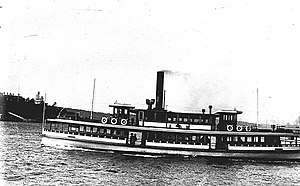 as built circa 1914-1920 | Gertrude Denman, wife of fifth Governor-General of Australia | 96 tons | 33.5 m | 500 | Lady class, third series | |
| Barrenjoey, later North Head | 1913 |  As North Head 1972 | Barrenjoey headland and Aboriginal word for wallaby. North Head at entrance to Sydney Harbour | 500 tons, 1954: 466 tons | 64.0 m | 1509, 1951: 1278 | Manly ferry, Binngarra type | 1985 |
| Kameruka | 1913 | 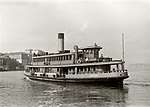 as a steamer, likely 1930s or 40s | Australian Aboriginal word meaning 'wait til I come' | 144 tons | 34.1 m | 594 | K class | 1984(?) |
| Lady Edeline | 1913 | 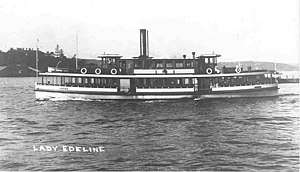 as a steamer | 96 tons | 33.7 m | 544 | Lady class, third series | 1984 | |
| Karrabee | 1913 | 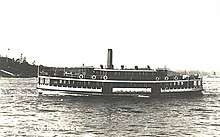 as built as a steamer | Australian Aboriginal word for 'Cockatoo' | 107 tons | 32.8 m | 653 | K class | 1984 |
| Karingal | 1913 | 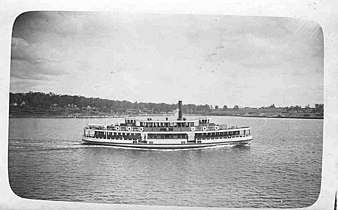 as a steamer | Australian Aboriginal word meaning 'happy home' | 107 tons | 31.7 m | 608 | K class | 1984(?) |
| Woollahra | 1913 | 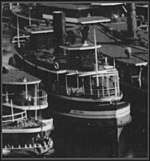 | Australian Aboriginal word meaning 'camp', 'meeting ground' or a 'sitting down place' and the name of a Sydney suburb | 152 tons | 38.1 m | 1941 | ||
| Kuramia | 1914 | 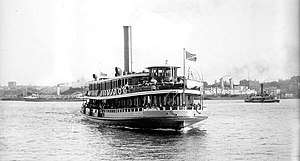 | 335 tons | 47.7 m | 1357 | K class | ||
| Kedumba | 1914 |  | Australian Aboriginal word for 'falling water' | 294 tons | 40.1 m | Vehicular ferry | ||
| Lady Scott, later John Cadman | 1914 | 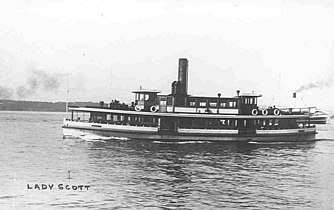 | 95 tons | 33.5 m | 486 | Lady class, third series | 1969 | |
| Lady Ferguson | 1914 | 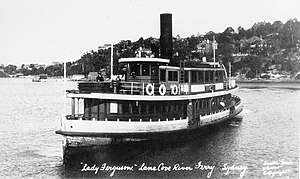 | Lady Helen Hermione, wife of Ronald Munro Ferguson, 1st Viscount Novar | 96 tons | 33.5 m | 490 | Lady class, third series | 1975 |
| Kurnell, formerly Romantic | 1916 |  | K class | 1942 | ||||
| Kooroongaba | 1921 | .jpg) | Australian Aboriginal word for 'pelican' | 313 tons | 41.8 m | 45 vehicles, 220 passengers | Vehicular ferry | 1932 |
| Narrabeen (II) | 1921 | _built_1921_on_sea_trials.jpg) | Named after Sydney suburb of Narrabeen | 235 tons | Cargo ferry | 1928 sold to Victoria, 1858 wrecked | ||
| Baragoola | 1922 | 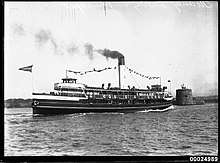 | Australian Aboriginal word for "Flood tide"[87] | 498 tons | 60.7 m | 1523 | Manly ferry, Binngarra type | 1983 |
| Kuttabul | 1922 | 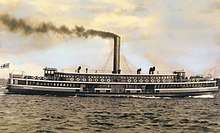 | Australian Aboriginal word for 'wonderful' | 447 tons | 55.7 m | 2089 | K class | 1932 |
| Koompartoo | 1922 | 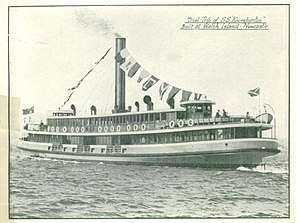 | Australian Aboriginal word meaning 'a fresh start' | 447 tons | 55.7 m | 2089 | K class | 1932(?) |
| Koondooloo | 1924 | 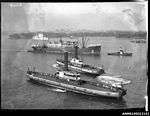 | Australian Aboriginal word for 'emu' | 350 tons | 58.5 m | 56 vehicles, 292 passengers | Vehicular ferry | |
| Kalang, later Sydney Queen | 1926 | .jpg) | Australian Aboriginal word meaning 'beautiful' | 350 | 57.0 m | 50 vehicles, 250 passengers. 2,153 passengers as showboat | Vehicular ferry | |
| Kara Kara | 1926 |  | Australian Aboriginal word for the moon | 350 | 57.0 m | Vehicular ferry | ||
| Curl Curl | 1928 | .jpg) | A suburb in Sydney's northern beaches. | 790 tons | 67.1 m | 1574 (summer) / 1235 (winter) | Manly ferry, Dee Why type | 1960 |
| Dee Why | 1928 | .jpg) | A suburb in Sydney's northern beaches. | 790 tons | 67.1 m | 1574 (summer) / 1235 (winter) | Manly ferry, Dee Why type | 1968 |
| South Steyne | 1938 | 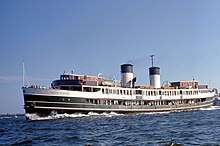 | The southern promenade of Manly Beach | 1203 tons | 66.1 m | 1781 | Manly ferry | 1974 |
| Rodney Regalia | 1938 | 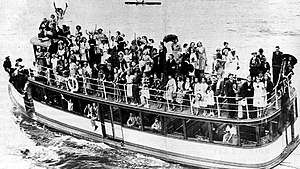 | ||||||
| Kooleen | 1956 | 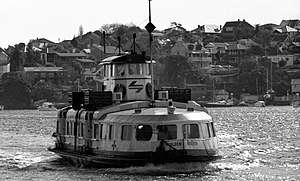 | 67 tons | 22.7 m | 278 | 1985 | ||
| Manly (III) | 1964 | Japanese built. The first hydrofoil service on Sydney Harbour | 31 tons | 20.7 m | 72 | Hydrofoil | ||
| Fairlight (II) | 1966 | 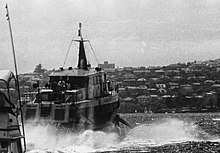 | 65 tons | 29.0 m | 140 | Hydrofoil | 1984 | |
| Lady Cutler | 1968 | Helen Cutler, wife of Roden Cutler, Governor of NSW | 404 tons | 36.2 m | 570 | Lady-class ferry | 1991 | |
| Lady Woodward | 1970 |  | wife of Eric Woodward Governor of NSW | 339 tons | 36.2 m | 570 | Lady-class ferry | |
| Lady Mckell | 1970 | 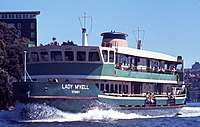 | 339 tons | 36.2 m | 570 | Lady-class ferry | ||
| Dee Why (II) | 1970 | Hydrofoil on Manly service | 65 tons | 29.0 m | 140 | Hydrofoil | 1985 | |
| Curl Curl (II) | 1973 | Hydrofoil on Manly service | 65 tons | 29.0 m | 140 | Hydrofoil | ||
| Lady Wakehurst | 1974 | 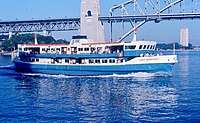 In her original Public Transport Commission colours | wife of John Loder, 2nd Baron Wakehurst, former Governor of NSW | 366 tons | 38.9 m | 820 | Lady-class ferry | |
| Lady Northcott | 1974(?) |  | wife of John Northcott former Governor of NSW | 366 tons | 38.9 m | 820 | Lady-class ferry | 2018(?) |
| Palm Beach | 1975 | 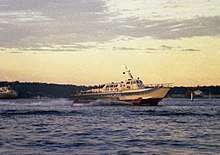 | 65 tons | 29.0 m | 140 | Hydrofoil | ||
| Lady Street | 1979 | Sister to Lady Herron | 350 tons | 35.3 m | 554 | Lady-class ferry | 2002(?) | |
| Lady Herron | 1979 | wife of Leslie Herron, Lieutenant Governor General of NSW | 350 tons | 35.3 m | 554 | Lady-class ferry | 2018(?) | |
| Freshwater | 1982 | 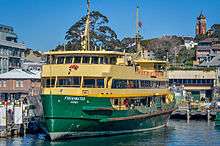 | Freshwater Beach | 1150 tons | 70.4 m | 1100 | Freshwater class | in service |
| Queenscliff | 1983 | .jpg) | Queenscliff Beach | 1140 tons | 70.4 m | 1150 | Freshwater class | in service |
| Narrabeen (III) | 1984 |  | Narrabeen Beach | 1150 tons | 70.4 m | 1100 | Freshwater class | in service |
| Sirius | 1984 | HMS Sirius, flagship of the 1787 First Fleet. | 105 tons | 25.4 m | 393 | First Fleet | in service | |
| Manly (IV) | 1984 | 105 tons | 31.2 m | 235 | Hydrofoil | 1991 | ||
| Sydney | 1985 | 105 tons | 31.2 m | 235 | Hydrofoil | 1991 | ||
| Supply | 1985 | HMS Supply, part of the 1787 First Fleet. | 105 tons | 25.4 m | 393 | First Fleet | in service | |
| Alexander | 1985 | 105 tons | 25.4 m | 393 | First Fleet | in service | ||
| Borrowdale | 1985 | Borrowdale, part of the 1787 First Fleet. | 105 tons | 25.4 m | 393 | First Fleet | in service | |
| Charlotte | 1985 | Charlotte, part of the 1787 First Fleet. | 105 tons | 25.4 m | 393 | First Fleet | in service | |
| Fishburn | 1985 | Fishburn, part of the 1787 First Fleet. | 105 tons | 25.4 m | 403 | First Fleet | in service | |
| Friendship | 1986 | Friendship, part of the 1787 First Fleet. | 105 tons | 25.4 m | 403 | First Fleet | in service | |
| Golden Grove | 1986 | Golden Grove, part of the 1787 First Fleet. | 105 tons | 25.4 m | 403 | First Fleet | in service | |
| Scarborough | 1986 | Scarborough, part of the 1787 First Fleet. | 105 tons | 25.4 m | 403 | First Fleet | in service | |
| Collaroy | 1988 | .jpg) | Collaroy Beach | 1140 tons | 70.4 m | 1150 | Freshwater class | in service |
| Betty Cuthbert | 1992 | Athlete Betty Cuthbert | 41 tons | 36.8 m | 230 | RiverCat | in service | |
| Dawn Fraser | 1992 | Swimmer Dawn Fraser | 41 tons | 36.8 m | 230 | RiverCat | in service | |
| Evonne Goolagong | 1992 | Evonne Goolagong | 41 tons | 36.8 m | 230 | RiverCat | in service | |
| Marlene Mathews | 1992 | Marlene Matthews | 41 tons | 36.8 m | 230 | RiverCat | in service | |
| Marjorie Jackson | 1992 | Marjorie Jackson | 41 tons | 36.8 m | 230 | RiverCat | in service | |
| Nicole Livingstone | 1992 | Nicole Livingstone | 41 tons | 36.8 m | 230 | RiverCat | in service | |
| Shane Gould | 1992 | Shane Gould | 41 tons | 36.8 m | 230 | RiverCat | in service | |
| Anne Sargeant | 1998 | netballer Anne Sargeant | 35 tons | 29.6 m | 150 | HarbourCat | in service | |
| Pam Burridge | 1998 | surfer Anne Sargeant | 35 tons | 29.6 m | 150 | HarbourCat | in service | |
| Louise Sauvage | 2001 | Paralympian Louise Sauvage | 48 tons | 37.8 m | 250 | SuperCat | in service | |
| Mary MacKillop | 2001 | Australia's first declared saint Mary MacKillop | 48 tons | 37.8 m | 250 | SuperCat | in service | |
| Susie O’Neill | 2001 | swimmer Susie O'Neill | 48 tons | 37.8 m | 250 | SuperCat | in service | |
| SuperCat 4 | 2001 | - | 48 tons | 37.8 m | 250 | SuperCat | in service | |
| Fred Hollows | 2017 | Renowned ophthalmologist Fred Hollows | 40 tons | 36.4 m | 400 | Emerald class | in service | |
| Victor Chang | 2017 | Renowned cardiac surgeon Victor Chang | 40 tons | 36.4 m | 400 | Emerald class | in service | |
| Pemulwuy | 2017 | Aboriginal leader Pemulwuy | 40 tons | 36.4 m | 400 | Emerald class | in service | |
| Bungaree | 2017 | Fred Hollows | 40 tons | 36.4 m | 400 | Emerald class | in service | |
| May Gibbs | 2017 | Children's author May Gibbs | 40 tons | 36.4 m | 400 | Emerald class | in service | |
| Catherine Hamlin | 2017 | Obstetrician and gynaecologist Catherine Hamlin | 40 tons | 36.4 m | 400 | Emerald class | in service | |
| Me-Mel (II) | 2019 | Gadigal word meaning "eye" and name for Goat Island | 12 m | 43 | MiniCat | in service |
Notes
- Gunter (1978), p. 11
- Prescott (1984), p 11
- Andrews, Graeme (1982). A Pictorial History of Ferries: Sydney and Surrounding Waterways. Sydney: AH & AW Reed Pty Ltd. ISBN 0589503863.
- Andrews (1982), page 11
- Prescott (1984), p. 58
- Andrews (1975), p 115
- Gunter (1978), p. 12
- Gunter (1978), p. 28
- Andrews (1982), pp 11-12
- Gunter (1978), p 17
- Prescott (1984), p. 60
- Andrews (1975), p. 115
- Andrews (1982), p.12
- Gunter (1978), p. 14
- Prescott (1984), p. 66
- Gunter (1978), p. 71
- Andrews (1982), p. 51
- Gunter (1978), p. 23
- Prescott (1984), p. 86
- Prescott (1984), p. 62
- Andrews (1982), p. 53
- Prescott (1984), p. 64
- Andrews (1982), p. 36
- Gunter (1978), p. 16
- Prescott (1984), p. 84
- Prescott (1984), p. 77
- Andrews (1982), p. 50
- Gunter (1978), pp 79-80
- Gunter (1978), p. 76
- Gunter (1978), p. 13
- Andrews (1975), p. 19
- Museum of Applied Arts & Sciences. "Glass plate negative of steam ferry 'Lily' and HMS 'Nelson', Farm Cove, Sydney, 1882-8". Museum of Applied Arts & Sciences, Australia. Retrieved 21 April 2020.
- Andrews (1982), p. 52
- Andrews (1982), p. 66
- Andrews (1982), p. 38
- Gunter (1978), p.72
- Prescott (1984), p. 85
- Gunter (1978), p. 33
- Prescott (1984), p 78
- Andrews (1982), p. 37
- Museum of Applied Arts and Sciences
- Andrews (1975), p. 30
- Gunter (1978), p 78
- Andrews (1982), p. 93
- Andrews, Graeme (1975). The Ferries of Sydney. A.H. & A.W. Reed Pty Ltd. p. 29. ISBN 0589071726.
- Gunter (1978), p 21
- Andrews, Graeme (1975). The Ferries of Sydney. A.H. & A.W. Reed Pty Ltd. p. 93. ISBN 0589071726.
- Museum of Applied Arts and Sciences
- Andrews (1982), p. 40
- The Herald
- Andrews (1982), p. 94
- Prescott (1984), pp. 36, 67
- Andrews (1982), p. 100
- Gunter (1978), p. 34
- Prescott (1984), p. 35
- Gunter (1978), p. 36
- Andrews (1975), pp. 93, 116, 117
- ferriesofsydney.com
- Gunter (1978), p. 73
- Prescott (1984), p. 74
- Prescott (1984), p. 30
- Ferries of Sydney - Kareela
- Andrews (1975), p. 92
- Prescott (1984), pp. 15-16
- Andrews (1982), p. 29
- Gunter (1978), p. 77
- Gunter (1978), p. 22
- Prescott (1984), p. 61
- Andrews (1982), p. 45
- Prescott (1984), p. 70
- "FIRE ON A FERRY ROAT". The Brisbane Courier. Queensland, Australia. 23 March 1911. p. 5. Retrieved 4 January 2020 – via Trove.
- Andrews (1975), p. 59
- Andrews (1982), p. 96
- Morcombe, John (26 May 2019). "The Bellubera Had Its Fair Share of Controversies During Its Time". The Manly Daily. Retrieved 6 June 2019.
- Andrews (1982), p. 104
- "Vale Lady Chelmsford". Dockland News. Retrieved 27 April 2019.
- Ferries of Sydney - Kiandra
- Andrews (1982), p. 97
- Prescott (1984), p. 71
- Andrews (1982), p. 98
- Prescott (1984), p. 37
- Gunter (1978), p. 57
- Prescott (1984), p. 73
- smh.com.au
- Andrews, Graeme (1975). The Ferries of Sydney. A.H. & A.W. Reed Pty Ltd. p. 31. ISBN 0589071726.
- Gunter (1978), p. 62
- savethebaragoola.com
- Andrews (1975), p. 89
- Andrews (1982), p. 65
- Prescott (1984), p. 63
- Gunter (1978), p. 74
References
- Andrews, Graeme (1975). The Ferries of Sydney. A.H. & A.W. Reed Pty Ltd. ISBN 0589071726.
- Andrews, Graeme (1982). A Pictorial History of Ferries: Sydney and Surrounding Waterways. Sydney: AH & AW Reed Pty Ltd. ISBN 0589503863.
- Gunter, John (1978). Across the harbour : the story of Sydney's ferries. Rigby. ISBN 0727007157.
- Prescott, AM (1984). Sydney Ferry Fleets. Magill South Australia: Ronald H Parsons. ISBN 0909418306.
This article is issued from Wikipedia. The text is licensed under Creative Commons - Attribution - Sharealike. Additional terms may apply for the media files.